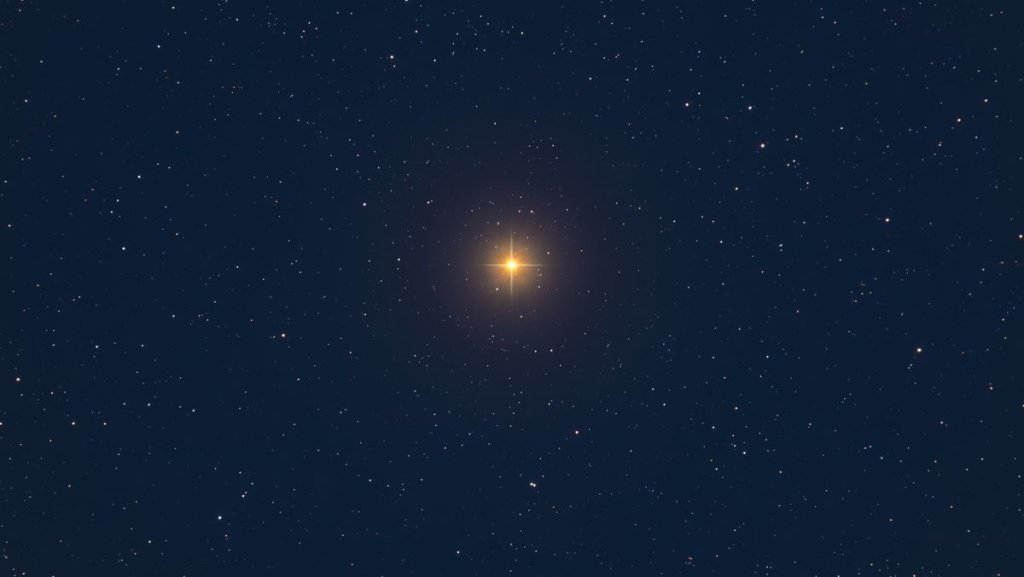Betelgeuse, the second-brightest star in the familiar constellation Orion, is a strange, giant star. Recent observations have revealed that it spins much faster — and has many more heavy elements mixed within it — than typical giant stars should. Recently, a team of astronomers developed a sophisticated computer simulation to explore a radical idea: That Betelgeuse is the result of a merger between two smaller stars.
All stars follow well-understood evolutionary tracks. They fuse hydrogen in their cores for the vast majority of their lives, leaving behind a buildup of helium as they age. Changing the ratio of hydrogen to helium in the core affects the rest of a star’s properties, like its size, brightness and temperature. For example, when more massive stars like Betelgeuse near the ends of their lives, they develop so much helium in their cores that hydrogen fusion moves into a shell surrounding that core, inflating the rest of the star into a red supergiant.
Using this knowledge, astronomers can usually pinpoint where a star is on its evolutionary track. But Betelgeuse has some strange properties: It contains far more nitrogen in its outer atmosphere, which is a sign that its interior has been mixed recently, and it’s spinning far faster than other red supergiants, indicating that something happened to the star to spin it up.
Related: The mysterious dimming of supergiant star Betelgeuse may finally be explained (photo)
Putting these pieces together, astronomers recently performed a systematic and careful analysis of the intriguing possibility that Betelgeuse did not start off as a single star but is instead the product of a “quiet merger.” They reported their results in a preprint paper submitted to The Astrophysical Journal.
The team’s setup was a binary system, which is extremely common among high-mass stars in the galaxy. In their simulation, the primary star was 16 solar masses and already well on its way to becoming a red supergiant. The companion star was much less massive, around four solar masses, and was still happily fusing hydrogen in its core.
As the supergiant star aged, its atmosphere extended to the orbit of its companion, the simulation revealed. The companion star’s gravity funneled that material onto itself, increasing its own mass. Eventually, the companions started swimming through so much material that this caused friction, thus slowing the companion and drawing it inward. What happened next depended on a variety of factors, including the speed of the companion, the stars’ relative masses, and how much of the primary star’s atmosphere had been extended.
Sometimes the merging stars briefly flared, resulting in a significant loss of mass and thus a much smaller, highly disrupted star, the simulation showed. But in Betelgeuse’s case, the merger was much quieter. The companion plunged into the primary star’s atmosphere, spiraling inward and eventually merging with the helium core. This process released an enormous amount of energy, ejecting some of the star’s material into space in jet-like outflows roughly equivalent to 60% of the sun’s mass.
The influx of new material from the companion star disrupted the helium core, briefly returning the newly merged star to a hydrogen core fusing stage, the simulation showed. This didn’t last long, however, and the newborn Betelgeuse soon became a red supergiant again.
However, Betelgeuse retained a memory of the collision. In the astronomers’ model, the merger mixed up the contents of the star, sending heavier elements, like nitrogen, into the upper reaches of the atmosphere, where some of it remains visible today. And the merger added a significant amount of rotational energy to Betelgeuse. While the star presumably slowed down somewhat since that theoretical violent merger, it’s still rotating much faster than it should be.
Unfortunately, direct evidence for this scenario won’t be easily apparent for another 50,000 to 100,000 years, when Betelgeuse explodes as a supernova. When that happens, material from its inner depths will race outward, allowing future astronomers (if they exist at that time!) to study the chemical makeup of the giant star in more detail. The proportion of elements will tell them whether Betelgeuse was always a solitary star with strange properties or if it was the result of a merger long ago.

